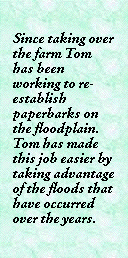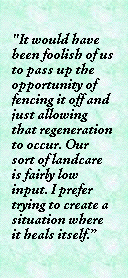
Tom Murray, Dalyup

|
Re-establishment of floodplain vegetation
Tom Murray, Dalyup |
 |
Background
The Murray Road property was first settled in the 1890s, which made it one of the earliest properties settled in the Dalyup area. It is situated in the lower catchment of the Dalyup River, which flows along the northern edge of the property before emptying into Lake Gore, which abuts the property to the west. The property is about 2300 hectares in total and of that only 700 hectares is arable owing to the presence of a large area of coastal dunes and numerous wetlands and intervening floodplain. Some of the land on the floodplain had already been cleared when Tom's parents bought the property in 1950. Tom's father did some clearing but Tom says, "My father wasn't one for knocking down paperbark trees, if it was paperbark you didn't clear it. We're defenders of paperbarks and flat-topped yates". The property mostly supports sheep and cattle grazing and vineyards. The Murray's first started fencing more than 20 years ago to exclude the stock from a 40 hectare wetland. "We just like the idea of having some bush around. It's certainly not sustainable to have livestock on those areas because you get no regeneration there. You're going to lose it ultimately". Since taking over the farm Tom has been working to re-establish paperbarks on the floodplain. Tom has made this job easier by taking advantage of the floods that have occurred over the years. The Problem In the 1950s Tom's father had trouble finding dam sites. He found that if he went down more than a metre and a half deep he would tend to get into a saline watertable. Later Tom became concerned about the potential problems connected with the shallow saline watertable as he had noticed areas on the property where salinity had increased. He is hoping that is does not rise to a point where it becomes a problem for the pastured areas. He was also concerned about some of the areas that had been grazed for over 50 years, as there had been no regeneration of native vegetation to help suppress any rising watertable problems. Being at the bottom end of the Dalyup Creek catchment the property receives everything from higher up. Tom is concerned about the fact that upstream some landholders are draining their land and putting more water into the creek system. "Drainage is seen as essential to the continued viability of farming in the upper catchment of the Dalyup. I believe the solution to their salinity problem lies in their own back yard with increased water use. Drainage may be part of the solution, but it can't be done without regard for the natural drainage system and the recipient areas. This applies to the rate and volume of runoff and total effluent loads. In particular with a closed system, like Lake Gore, there is the likelihood of loss of the wetland vegetation essential to the survival of the ecosystem". Tom believes that the drainage in the upper catchment will increase the flood flow intensity and therefore will increase the water levels in the wetlands on his property. During January 1999 the area experienced a major flood, the biggest Tom had seen and it was the first time his section of the Dalyup River had broken its banks. This flood changed the face of the farm because as the river broke banks it flowed through the paddocks to the south and destroyed fences and scoured out erosion channels. The flood also dumped a lot of silt and changed the course of the river slightly so a crossing had to be reconstructed.
After a flood in 1989 Tom started fencing off areas to allow natural regeneration of the native vegetation to occur. He had noticed that melaleucas and yates regrew from the seed that was deposited at the high water level after the floodwater receded. He explained that, "We have planted a few trees but we champion what's here. The areas that do flood are really ideal for melaleucas and yates". The first area that he fenced off was a pastured paddock prior to 1989. "We had a very wet year in '89 and all that area was inundated with water. When the water receded there were a lot of paperbarks that came up, so we didn't ever get to put the stock back in and it has re-established a very good stand of melaleucas and yates, which we have no intention to clear". The area had a fire through it in December 1997 and Tom says that it has recovered well. Tom has found that the flooding has given him an opportunity to allow for the natural regeneration of the wetlands. "We hope to fence off all these paperbark areas and areas that are wet during the winter. You can see the yate that's germinated from the flooding and it beats planting trees. You can see the massive germination of paperbarks. I'm confident that we'll get more paperbarks and things from successive lots of seed amongst the litter as the water recedes".
The wetland adjacent to Lake Gore on the western boundary of the property was fenced in about 1994. Tom explained that, "There's several lunettes associated with Lake Gore and the paperbark has been dying on those. I guess that's just a function of the increased water that's coming down the river from the clearing. There's probably not much we can do to arrest that. This area was grazed up until seven or eight years ago and the samphire has re-established in the lower areas. But I don't know what the extent of regeneration will be out through these lunettes. I guess we'll have to wait and see".
We had pasture down to that point and it wasn't salt affected so I thought that it was a reasonable level to have the fence at. Now the water is about a metre higher. In the future it may well stay dry down to there but to increase the riparian zone with a strip along the edge I think was a great opportunity and we just had to take it. We regard that as something good that we got from the floods". Tom is also planting trees in areas that were eroded during the flood. "The flood scoured out some bends on the river and they are not useable for grazing or anything so we're fencing them off and planting some trees. We've planted an area to pines and in the lower sections we've put in paperbarks (Melaleuca cuticularis) and yates. The wattles and paperbarks are also coming back. With the damage to this area we thought that it was pointless fencing it into a paddock, so we fenced it out and planted the pines along the ridge and also planted a range of trees and shrubs along the rip lines. We have noticed that in a couple of spots a good way to get yates going is brushing using branches that were lodged in the trees after the floods". Most of the fencing has been erected and financed by the Murrays except for a section of remnant vegetation on the river. "We're using all electric fencing around the remnant vegetation and that way we can go around curves and things fairly economically and it's a lot cheaper for materials. With the remnant vegetation we don't have livestock on both sides so the fences don't come under quite so much pressure as when they're on both sides". Tom is in the process of fencing off a section of a drainage line in the northern section of the property at present and he will probably plant some trees just to kick start things. He has also done some planting directly along the river on areas where previously the paddock went right up to the bank.
Tom is very pleased with the results of his fencing after flooding. "It would have been foolish of us to pass up the opportunity of fencing it off and just allowing that regeneration to occur. Our sort of landcare is fairly low input. I prefer trying to create a situation where it heals itself. Because I think in many cases there is the capacity there for it to do that, particularly with the species that we have down here that are well adapted".
Tom has noticed that weeds are a problem in some areas where stock has been excluded and also weed seeds are carried downstream to him after a flood. "With the floods we copped a fair amount of lovegrass, there was no lovegrass in some of the paddocks before the flood, and we even got a few doublegees".
Dalyup River Catchment Statistics
|
||||||||||||
 |
|||||||||||||
 |
|||||||||||||